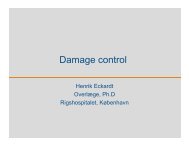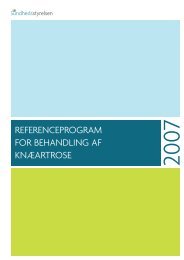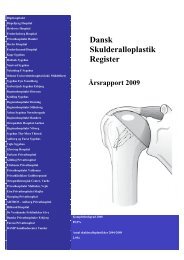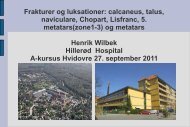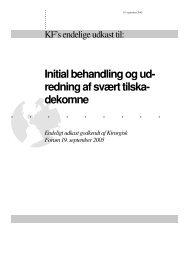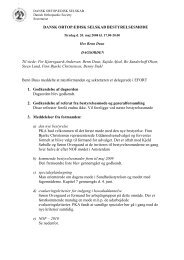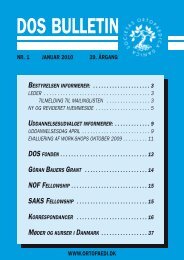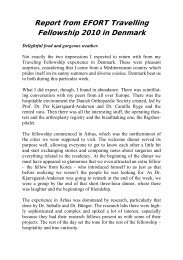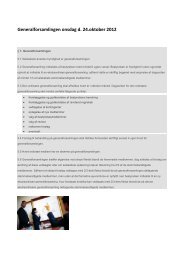DOS BULLETIN - Dansk Ortopædisk Selskab
DOS BULLETIN - Dansk Ortopædisk Selskab
DOS BULLETIN - Dansk Ortopædisk Selskab
You also want an ePaper? Increase the reach of your titles
YUMPU automatically turns print PDFs into web optimized ePapers that Google loves.
2010-378_<strong>DOS</strong> nr. 3 2010 29/09/10 10:08 Side 120<br />
Ortostatic intolerance during early mobilization after<br />
total hip arthroplasty<br />
Øivind Jans, Søren Solgaard, Morten Bundgaard-Nielsen,<br />
Pär I. Johansson, Henrik Kehlet<br />
Section of Surgical Pathophysiology, Rigshospitalet; Department of<br />
Orthopedic Surgery, Hørsholm Hospital; Section of Surgical Pathophysiology,<br />
Rigshospitalet; Capital Region Blood Bank, Rigshospitalet<br />
Background: Early postoperative mobilization is a cornerstone in fasttrack<br />
hip arthroplasty (THA). However, postoperative orthostatic intolerance<br />
(OI) may delay early recovery or lead to complications. OI have<br />
been attributed to impaired fluid balance, postoperative anaemia or the<br />
use of opioid analgesics. However, the prevalence of OI or the association<br />
between OI and these factors has not been established after THA<br />
Purpose: We evaluated the orthostatic function and cardiovascular<br />
responses to mobilization before and after surgery in fast-track THA<br />
patients.<br />
Methods: Orthostatic tolerance was evaluated in 26 patients scheduled<br />
for THA and undergoing spinal anaesthesia, before, 6 and 24 hours after<br />
surgery. An opioid sparing analgesic regime was administered. Systolic<br />
(SAP)- and diastolic (DAP) arterial pressure, heart rate (HR) and cardiac<br />
output (CO) were measured non-invasively using the Nexfin® system<br />
and cerebral (ScO2) and muscular (SmO2) tissue oxygenation were<br />
recorded using non- infrared spectroscopy (Invos®).<br />
Findings: No patients demonstrated OI before surgery, whereas 11<br />
(42%) and 5 (19%) patients had OI 6 and 24 hours after surgery, respectively.<br />
3 (12%) patients had ortostatic hypotension, but no symptoms of<br />
OI 6 hours after surgery. Before surgery, SAP, DAP and HR increased (P<br />
< 0.05) while CO remained stable upon standing. At 6 and 24 hours after<br />
surgery SAP, DAP, CO and ScO2 decreased (P < 0.05) in patients with<br />
OI but remained stable in patients without OI. There were no association<br />
between postoperative Hb or opioid use and OI.<br />
Conclusion: Early postoperative OI is common after THA and is associated<br />
with a diminished cardiovascular response to standing and<br />
decreased cerebral oxygenation. Further research on OI after THA<br />
should focus on fluid dynamics and haemodynamic adaptation to early<br />
mobilization.<br />
120



